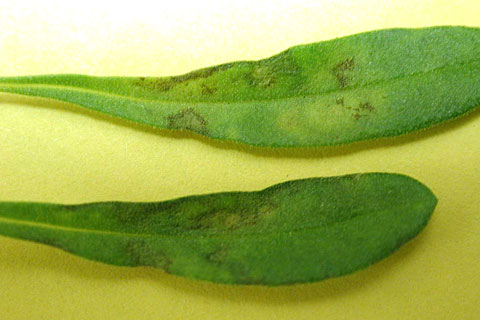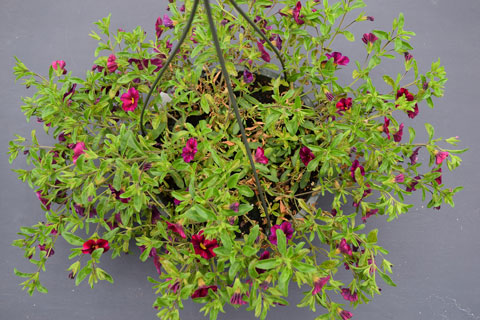2/1/2023
Two Tobamoviruses to Keep an Eye Out For
A.R. Chase & Margery Daughtrey

Virus symptoms are notoriously hard to identify just by looking. They can be mimicked by genetic variegation, or by certain other diseases or disorders, even spray injury—especially from overspray or drift from herbicides. One virus disease can easily be mistaken for another.
Pictured: Close-up TMV symptoms.
Tobacco mosaic virus (TMV) and tomato mosaic virus (ToMV) are two very closely related viruses that you may encounter on many different greenhouse crops. Identifying ToMV or TMV may start by looking for mottling or mosaic in leaves, yellowing or browning of veins, leaf strapping, stunting or dieback of plants. Confirmation of the disease can be done at a university or private diagnostic lab, or on-premises using a test kit, such as the ImmunoStrips sold by Agdia, Inc. A test kit for TMV will pick up both TMV and ToMV.
ToMV has recently been reported on some calibrachoas causing yet another “outbreak” stemming from propagative materials. ToMV historically is a serious problem on tomatoes and it can infect petunias, causing symptoms in some petunia cultivars, but not others.
In 2001, United Kingdom researchers showed that ToMV also infected both verbena and calibrachoa, as well as bacopa, convolvulus, diascia, felicia and fuchsia. Unfortunately, many of these plants didn’t develop symptoms.
We have no images of symptoms of ToMV on petunia or calibrachoa to share with you, which is an indication that this particular virus hasn’t been a common problem in the U.S. greenhouse industry. Keeping track of the symptoms to be expected is nearly impossible because we constantly introduce new species and cultivars of host plants and also discover new viruses, as well as variations of “well-known” viruses. We know that ToMV is a tobamovirus that’s closely related to Tobacco mosaic virus (TMV) and this helps us to draw some inferences about ToMV.
TMV is a virus with a very large host range (similar to ToMV), including many ornamentals and especially plants in the Solanaceae family, such as tobacco, tomato, pepper and petunia. Virologists have long recognized Tomato mosaic virus (ToMV), but until very recently, ToMV was often lumped with TMV. ToMV shares many characteristics of TMV, including how it spreads and the methods that can help control it. Due to the overlap in symptoms, differentiating the species of these tobamoviruses may not be possible visually or with simple laboratory tests—and perhaps it’s not critical to separate them in order to make appropriate crop management decisions. Images we’ve collected of what we thought were TMV cases on calibrachoa in the past may in fact have been ToMV because we were relying on serological tests that didn’t separate the two.
Tobamovirus history
TMV has been a periodic problem primarily on petunia in ornamental production, which first appeared with the introduction of vegetatively propagated petunias. In 2010, Lewandowski, Hayes and Adkins (Ohio-ARS research team) identified a strain of TMV originating from petunia that caused strong mosaic symptoms. Other strains of TMV could, in some cases, infect petunias without causing any symptoms. This inconsistency in symptoms makes tracking and thus eliminating spread of the virus especially difficult.
In 1989, researchers at EPCOT Center (Walt Disney World) led some work on reducing spread of ToMV by cutting tools. The best tool treatments were: 10% trisodium phosphate, a combination of bleach and Ivory liquid soap, and RD20 (a quaternary ammonium disinfestant). Use of Ivory soap alone or 70% ethanol was ineffective. Lewandowski’s group at The Ohio State University also published extensive research on reducing the spread of TMV on knives by chemical dips.
I t's important to know the general “family” of a virus you encounter in the greenhouse simply because the way they spread can be unique to that virus family. Tobamoviruses are spread mechanically—merely by contact—so cleaning bench surfaces is an important concern.
t's important to know the general “family” of a virus you encounter in the greenhouse simply because the way they spread can be unique to that virus family. Tobamoviruses are spread mechanically—merely by contact—so cleaning bench surfaces is an important concern.
Pictured: TMV symptoms on a calibrachoa.
Other viruses are spread by aphids, thrips or even eriophyid mites, e.g., so sanitation of greenhouse surfaces isn’t as important in those cases and control focuses instead on the virus vector (the insect or mite spreading the virus).
Tobamovirus infections are systemic, and an infected plant cannot be cured, so it’s critical to discard plants with symptoms and to clean all surfaces for effective disease management. Knowing the virus family allows us to design the best control strategy.
Cleaning surfaces and tools
When it comes to plant surfaces, tobamoviruses like TMV and ToMV can be “controlled” by using nonfat dry milk as a spray prior to transplanting petunias. This was originally discovered in tobacco transplant greenhouses where TMV caused serious losses. Milk is relied upon in the tobacco industry for inactivation of viruses during transplant and was shown to be very effective at reducing virus transmission to petunias via cutting tools.
TMV persists on inanimate surfaces in the greenhouse for years if undisturbed and must be inactivated with nonfat dry milk, a 1:9 dilution of bleach, Virkon S or some other effective surface-disinfestant. If you choose to use nonfat dry milk on your surfaces, be aware that the sugar in the milk may lead to a very serious sooty mold infestation, which CANNOT be controlled with fungicides. Ann has tried a wide range of products against sooty mold without finding a successful treatment, so don’t trade one problem for another. The inactivation by nonfat dry milk may also be relatively temporary, so standard disinfestants will be more valuable on inanimate surfaces.
Prevention is key. Any ornamentals grown from cuttings that are highly susceptible to TMV (think petunias, calibrachoas and verbenas, in particular) need to be produced in meticulous clean stock programs. TMV must be excluded from the stock plant area by very careful sanitation and monitored for by rigorous testing procedures. Incoming plant material must be carefully screened. Even seed can be a source of TMV or ToMV, as the seed coat may be externally contaminated and then infect a seedling through minor wounds made during germination. GT
A.R. Chase is with Chase Agricultural Consulting. Margery Daughtrey is at the LIHREC Riverhead, Cornell University.
Precautionary Measures to Reduce Potential Spread of ToMV
• Don’t overreact—this is not a new virus.
• Don’t touch petunias or calibrachoas unless necessary and then disinfest your hands after each handling. Use disposable gloves, preferably, and never touch plants for grooming purposes. When you’re gathering infected plants to discard, do this at the end of the day, wear a disposable suit if possible and launder clothing before re-use if not. You can move ToMV (and other tobamoviruses) even when you think the plants aren’t infected.
• Separate incoming petunia/calibrachoa liners or cuttings. (With mixed plant containers this will not be possible).
• Scout your plants—at least initially and thereafter every other day, looking for strapped, mottled or mosaicked leaves, yellow or brown veins, stunting or dieback.
• Get some ImmunoStrip test kits (Agdia, Inc.) or another lateral flow serological test to allow a rapid confirmation of TMV. Closely related viruses, including ToMV, will give positive reactions in the Agdia test.
• Only test plants with symptoms—random testing except at the clean stock propagator level isn’t effective, is costly and gives us a false sense of security.
• If a test is positive, dump the plant/pot. If losses are potentially extensive, take photographs of symptoms and test results, notify your supplier and use a university or commercial lab as backup. Losses during a TMV outbreak a few years ago were higher because growers didn’t immediately give up on containers with mixed plantings when a petunia tested positive. If you insist on keeping the containers, do not replace a symptomatic calibrachoa with any plant that’s a host of ToMV or TMV—and remember they both have wide host ranges.